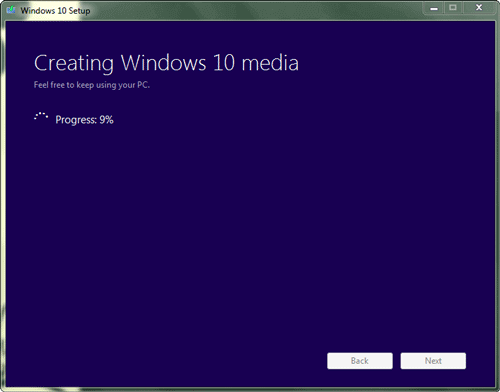
This option will use the Media Creation Tool from Microsoft to download an ISO file and create a bootable USB flash drive that is 32-bit, 64-bit, or both, and be used to install Windows 10 with or without UEFI. 6 Uncheck the Use the recommended options for this PC box. (see screenshot below) Leaving. Step 3: Choose writable USB device as media to copy Windows 10 ISO image file. Insert a writable USB drive into computer and click on USB device to select it as media type you would like to use to create a copy of Windows 10 system file. Step 4: Make a bootable USB for Windows 10 with Windows 7 USB/DVD download tool.
If you’d like to install Windows but don’t have a DVD drive, it’s easy enough to create a bootable USB flash drive with the right installation media. Here’s how to get it done for Windows 10, 8, or 7.
Create Windows 10 bootable USB with Universal USB Installer. The Universal USB Installer or UUI is an open source application for Windows to create linux live USB of various distributions. But it's not limited to Linux/UNIX distros only, it can also create windows 10 install USB. So, here's the steps below to create a windows 10 bootable USB. Here’s a look at using the utility called Rufus to create a bootable USB flash drive for Windows 10 which is actually much faster than Microsoft's tool. Aug 28, 2019 Usually, when you have to install a clean copy of Windows 10, you'll need a USB bootable media to start your device and continue with the setup wizard. However, if you're using a. If you’d like to install Windows but don’t have a DVD drive, it’s easy enough to create a bootable USB flash drive with the right installation media. Here’s how to get it done for Windows 10, 8, or 7. A Windows 10 installation USB drive is an essential tool for computer support. It can be used to boot and repair a broken Windows installation or install fresh on a new computer. Follow our simple step by step guide to creating a bootable USB drive from official Microsoft sources easily.
In this guide, we’ll be making a simple USB drive that acts just like an installation DVD, and lets you install one version of Windows. If you’d like to create a USB drive from which you can install multiple versions of Windows, you’ll want to follow these instructions instead.
Step One: Create or Download an ISO for the Windows Installation Media
Before you can create your USB installation drive, you’ll need to have your Windows installation media available as an ISO file. If you already have an installation DVD, you can use it to create an ISO file using ImgBurn, a handy little free utility that’s been around forever. If you don’t have Windows installation DVD, you can download ISO files for Windows 10, 8, or 7 directly from Microsoft.
You’ll also need a minimum of a 4GB flash drive to create your installer. Be sure to copy anything you want off of it, because this process will erase it. Once you have both your ISO and flash drive in hand, you’re ready to continue.
Step Two: Create Your Installation USB Drive with the Windows USB/DVD Download Tool
With your ISO file saved to your computer, your next step is to download and install the Windows USB/DVD Download Tool. The description on that page, on the actual download page, and on the tool itself talk a lot about Windows 7 and even XP. Don’t let that worry you. The tool works just fine for Windows 7, 8, and even 10.
Once you’ve got the tool installed, creating your USB installation drive is a pretty straightforward process. Run the tool and give it permission to make changes to your PC. Click “Browse” to locate your Windows ISO file and then click “Next.”

Create Windows 10 Usb Installation Media
On the next page, click “USB device.” The tool can also burn the ISO to a DVD if you need that option.
Use the drop-down menu to choose the USB flash drive you want to use. If you haven’t inserted it yet, do that now, and then click the Refresh button. Once you’ve got the right drive selected, click “Begin copying.”
If your USB drive has anything already on it, you’ll next see a warning that it will be formatted and you’ll lose any data stored on the drive. Go ahead and click “Erase USB Device.” If you started with a newly-formatted USB drive, you won’t see this warning.
Now you just have to wait for the process to complete, which usually takes 15-20 minutes. The drive will be formatted and files copied to the flash drive.
When the process is finished, you can close the download tool.
If you take a look at the flash drive in File Explorer, you’ll be able to see the same files that you would if you opened the installation DVD.
Create A Windows 10 Bootable Usb
And now that you have your installation USB drive, you can use it to start the computer on which you want to install Windows. You may have to fiddle with the BIOS on the computer to allow it to boot from USB or to change the boot order so that it will boot from the USB first. You may even be able to use the disk on computers that don’t support booting from USB, but you’ll need to take additional steps to create a bootable CD.
READ NEXT- › How to Use Text Editing Gestures on Your iPhone and iPad
- › Windows 10’s BitLocker Encryption No Longer Trusts Your SSD
- › How to Disable or Enable Tap to Click on a PC’s Touchpad
- › How HTTP/3 and QUIC Will Speed Up Your Web Browsing
- › Motherboards Explained: What Are ATX, MicroATX, and Mini-ITX?